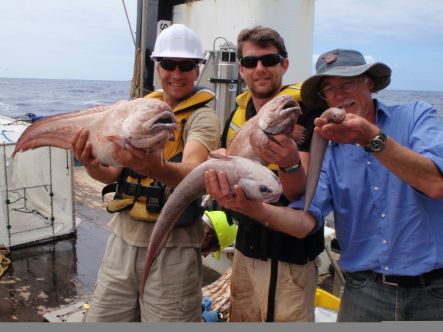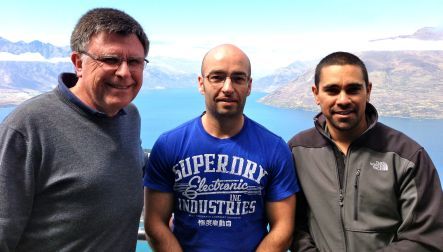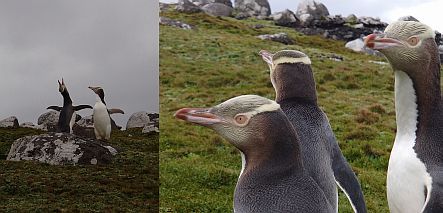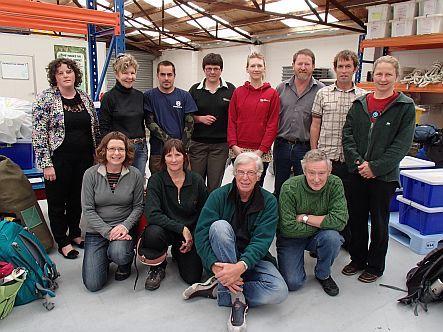Our Changing World for Thursday 7 February 2013
Life in the Deep Ocean

New and rare fish from the deep ocean: Steve Bailey (left), expedition leader Alan Jamieson and Te Papa’s fish biologist Andrew Stewart (right) hold specimens of a deep-sea cusk eel, cosmopolitan rattail and the newly discovered eelpout. (image: Malcolm Clark, NIWA)
A team of marine scientists from NIWA, the University of Aberdeen and Te Papa Tongarewa recently returned from a survey of the oceans near the Kermadec Islands with a new species of deep-sea fish, large numbers of amphipods and thousands of images of previously unseen marine habitats. The voyage was the fourth leg of an expedition which has taken samples from waters between one and nine kilometres deep along the Kermadec Trench, well below the depth that light penetrates, to explore how the biodiversity in the trench differs from that at shallower depths and in other trench systems.
The Kermadec Trench is the fifth-deepest places on Earth, with depths exceeding 10 kilometres, and one of the coldest places in the ocean. During this voyage, the team caught about 100 fish in baited traps and discovered a new species of eelpout, new records of a rattail fish that hasn't previously been caught in the south-west Pacific and a large deep-sea cusk eel. They also caught another species of rattail, known as the Cosmopolitan Rattail, which was last captured off New Zealand by the HMS Challenger in a global scientific expedition in the 1870s.
Large numbers of amphipods were also sampled to add to the collection from earlier expeditions. Amphipods are a type of crustacean particularly common in the deep sea, and are found in greater numbers at greater depths. Typically, deep-sea amphipods are two to three centimetres long with the exception of the slightly larger 'giant' amphipod found in Antarctica. During an earlier expedition to the Kermadec Trench, the team caught several 'supergiant' amphipods, ten times the usual size.
In this story, NIWA principal scientist Malcolm Clark and voyage leader Alan Jamieson discuss how the results from this expedition add to the understanding of biodiversity in the deep sea around New Zealand. Our Changing World has followed this expedition and you can listen to our earlier interviews about supergiant amphipods and deep-sea snailfish.
Zebrafish and Human Disease

From left to right: Phil Crosier, Chris Hall and Jonathan Astin
Phil Crosier and research fellows Chris Hall and Jonathan Astin at the Developmental & Cancer Genetics group at the University of Auckland are using zebrafish to ask research questions that would not normally be possible in humans or even mouse systems.
Despite about 450 million years of evolutionary separation between zebrafish and humans there are remarkable similarities between the genes, cells and tissues of these two species, making it possible to understand aspects of human disease. For example, the group is trying to understand how the lymphatic system develops and its role in tumour growth; as well as using the zebrafish model as a screen to identify new purposes for old drugs
During development, zebrafish embryos are transparent and all the cells and tissues in a developing organ can be visualised using various microscopic imaging techniques. Zebrafish are also relatively inexpensive to maintain so research can be undertaken on a scale that would be prohibitively expensive in other models.
Phil Crosier takes Ruth Beran on a tour of the zebrafish facility where there are rows upon rows of zebrafish in tanks with filters bubbling away.
The University of Otago also has a zebrafish facility, which featured in a previous Our Changing World story – listen here to Julia Horsfield explain how they use zebrafish to study developmental diseases and human cancers, especially breast cancer.
Yellow-eyed Penguin Survey at the Auckland Islands

A pair of yellow-eyed penguins (left) sky-calling in an ecstatic display, and a group of penguins heading out to sea to feed in the morning (images: A. Ballance)
Hoiho - the ‘noise shouters’ or yellow-eyed penguins – are among the world’s rarest penguins. They’re found on the east coast of southern South Island and on Stewart Island, where they face challenges from predators, habitat loss and disease. They also live in the remote subantarctic, which has long been considered their stronghold. But only one count has ever been made of their numbers at subantarctic Campbell and Auckland islands, and that was by Peter Moore back in the late 1980s.
So in November last year the Department of Conservation and the Yellow-eyed Penguin Trust teamed up with six paying volunteers to carry out a survey of yellow-eyed penguins at the Auckland islands, and Alison Ballance went along to help with the counting. The counting was carried out as a series of beach and coast counts between 5 and 9 am each morning, and sites surveyed included Enderby Island, Ewing Island, Rose Island and Adams Island, along with North Harbour, Matheson’s Bay and Waterfall Bay on the main Auckland Island. During the survey the penguins were incubating eggs.
Although it is difficult to draw conclusions from just two surveys carried out 23 years apart preliminary results show that yellow-eyed penguin numbers in the Auckland Islands may have declined by a third from 1989 to 2012. A similar survey was also carried out on Campbell Island during November 2012 but those results have yet to be analysed.

The team - back row left to right: Marcy Taylor, Sharon Kast, Leith Thompson (Yellow-eyed Penguin Trust), expedition leader Jo Hiscock (DoC), Rachel Downey, David Houston (DoC), David Agnew (DoC), Megan Willans (DoC). Front row left to right: Alison Ballance (Radio NZ), Katie Underwood, Alister Robinson and Alan MacGee (image: A. Ballance)
Expedition leader was Jo Hiscock from the Department of Conservation. The expedition was based on the yacht Evohe, skippered by Steve Kafka.
Alison kept a blog which was posted on the Yellow-eyed Penguin Trust’s web page while the expedition was underway.
You can find further Our Changing World stories about wildlife and conservation in the subantarctic at the following links:
Subantarctic expedition to put boardwalk on Campbell Island
Peter Moore on royal albatrosses on Campbell Island
Louise Chilvers on New Zealand sealions at the Auckland islands
Peter McClelland on removing introduced mammals from subantarctic islands
Kath Walker and Graeme Elliott on Gibson’s wandering albatrosses on Adams Island
Simon Childerhouse on southern right whales
